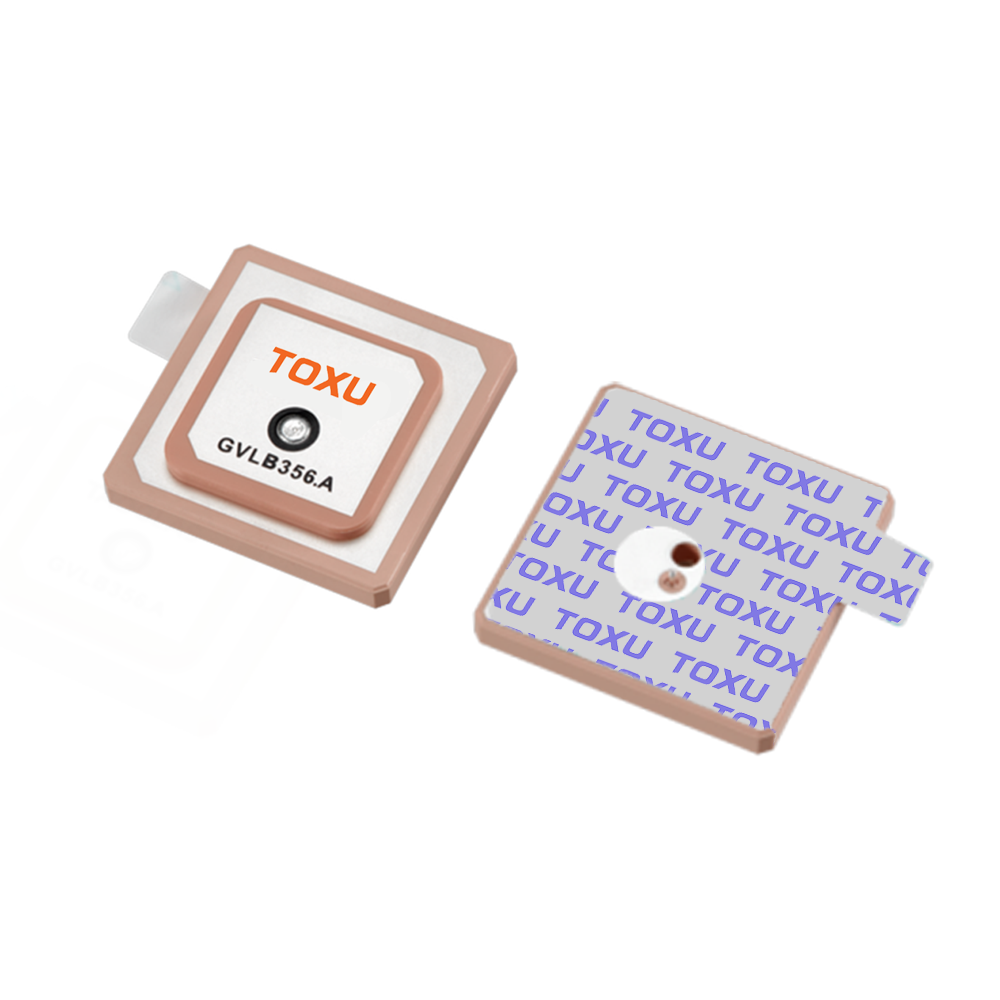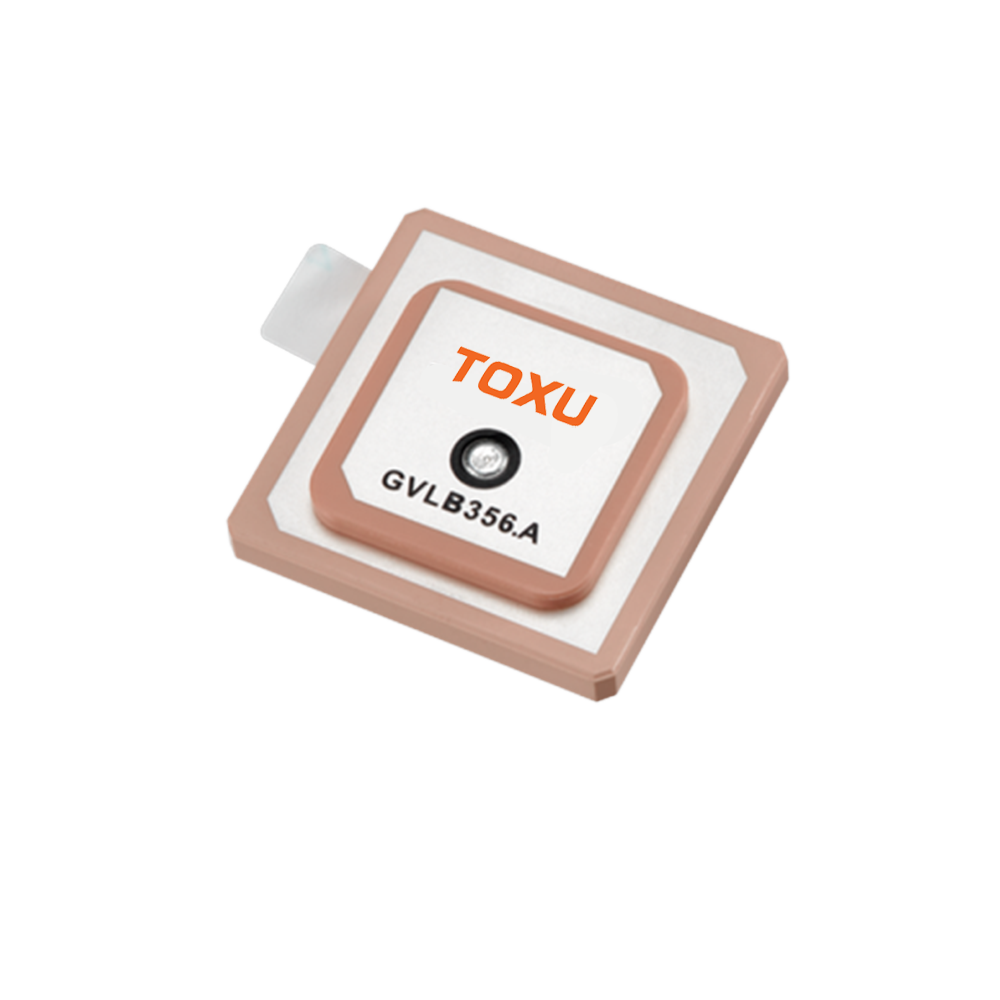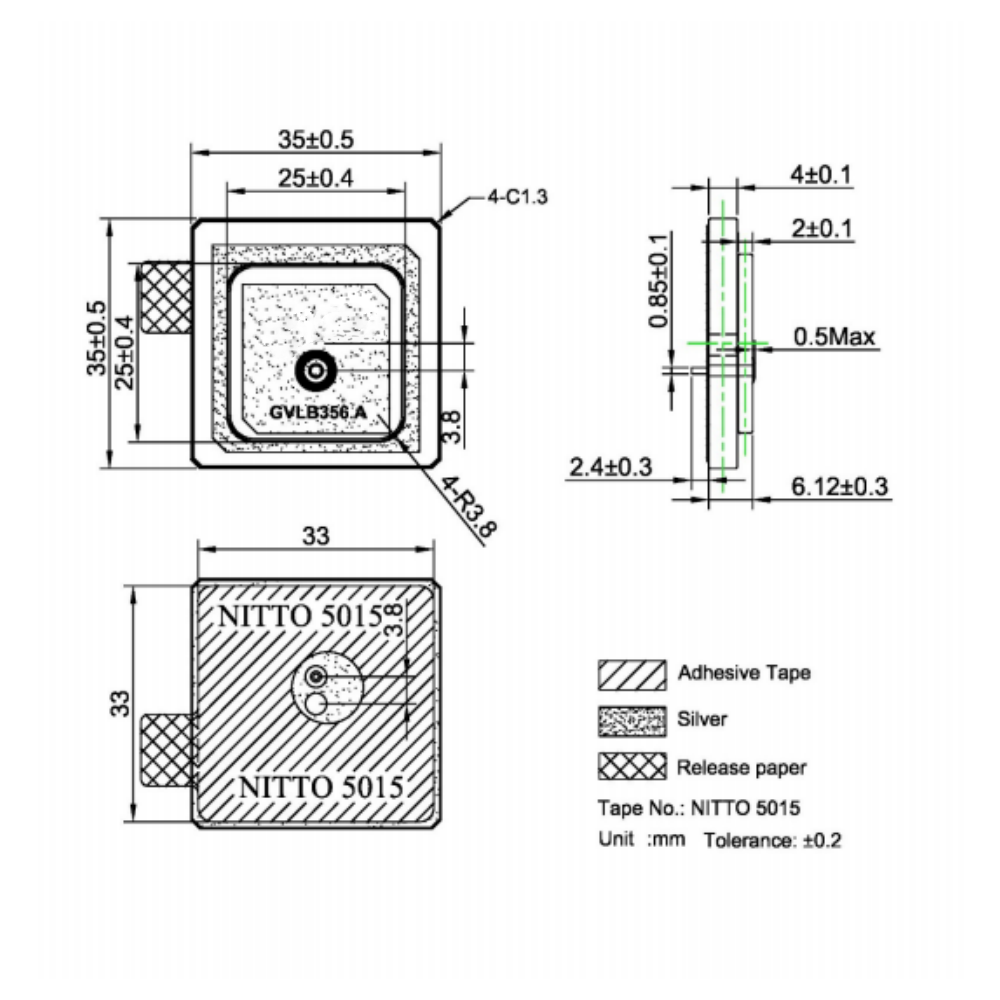At the heart of a passive GNSS ceramic antenna lies a meticulously engineered ceramic resonator, often crafted from materials like barium titanate or zirconium titanate. This ceramic core is the antenna’s signal-capturing powerhouse, designed to resonate at precise frequencies corresponding to the bands used by GNSS satellites. Ceramics are chosen for their exceptional dielectric properties—their ability to store and release electrical energy efficiently. This property is vital because GNSS signals travel vast distances from space, arriving at the Earth’s surface as weak electromagnetic waves. The ceramic resonator amplifies these faint signals by concentrating their energy, ensuring that even low-strength transmissions are detectable and usable for positioning calculations. The dielectric constant of the ceramic material is carefully calibrated; a higher dielectric constant allows for a more compact antenna design without sacrificing signal reception capability, a key factor in the 70x70mm PCB dimension specified for this antenna.
A defining feature of this passive GNSS ceramic antenna is its broad frequency range, which spans critical bands for both GPS and BDS. It covers GPS L1 (1575.42 MHz), L2 (1227.60 MHz), and L5 (1176.45 MHz), as well as BDS B1 (1561.098 MHz), B2 (1207.14 MHz), and B3 (1268.52 MHz). This multi-band capability is not merely a technical specification but a strategic advantage, enabling the antenna to tap into signals from a diverse array of satellites. For example, GPS L1 is the most widely used band in consumer applications, while L5 offers enhanced robustness against interference, making it crucial for safety-critical sectors like aviation and maritime navigation. BDS bands, on the other hand, strengthen coverage in the Asia-Pacific region, ensuring reliable positioning even in areas where other constellations may be less accessible. By supporting these bands, the antenna maximizes the number of visible satellites, thereby improving positioning accuracy, especially in challenging environments such as urban canyons or remote rural areas.
The gain specifications of 3.4 dBi at 1176 MHz (GPS L5) and 5 dBi at 1575 MHz (GPS L1) further underscore the antenna’s performance optimization. Gain, measured in decibels relative to an isotropic radiator (dBi), quantifies the antenna’s ability to focus signal energy in a specific direction. The 5 dBi gain at 1575 MHz ensures strong reception of the L1 band, which is fundamental for most everyday applications, from smartphone navigation to vehicle tracking. Meanwhile, the 3.4 dBi gain at 1176 MHz is tailored to the L5 band, striking a balance between signal amplification and coverage breadth. This dual-band gain tuning allows the antenna to adapt to varying signal strengths—boosting weaker L5 signals enough to ensure reliability while avoiding over-amplification of stronger L1 signals, which could introduce noise or distortion. Such precision is particularly valuable in passive antennas, which lack active amplifiers to adjust signal levels dynamically.
Polarization flexibility is another key attribute, with the antenna supporting both RHCP (Right-Hand Circular Polarization) and linear polarization. GNSS satellites transmit signals using RHCP, a design choice that minimizes signal loss caused by atmospheric scattering, reflections off surfaces like buildings or water, and Faraday rotation in the ionosphere. By matching the satellite’s polarization with RHCP, the antenna ensures maximum signal absorption, reducing the impact of environmental interference. Linear polarization, while less common in pure GNSS applications, offers utility in specialized scenarios. For instance, in indoor environments where signals are primarily reflected off walls, linear polarization can sometimes capture these reflected signals more effectively than RHCP. This dual polarization support empowers system designers to tailor the antenna’s performance to specific use cases, enhancing its adaptability across industries.
The VSWR (Voltage Standing Wave Ratio) of 1.5 is a critical indicator of the antenna’s efficiency in power transfer. VSWR measures the ratio of the maximum to minimum voltage in a standing wave pattern along a transmission line, with a value of 1 indicating perfect matching (no signal reflection). A VSWR of 1.5 means that only about 4% of the signal is reflected back to the source, with the remaining 96% being transmitted or received. This high efficiency is particularly important for passive antennas, as they cannot compensate for signal loss through amplification. In practical terms, a VSWR of 1.5 ensures that the antenna works seamlessly with connected devices, minimizing energy waste and maximizing the utilization of available signal strength. This efficiency is especially valuable in low-power applications, where every decibel of signal counts.
Input impedance is standardized at 50 ohms, a universally accepted value in RF (Radio Frequency) systems. This impedance matching is critical because it ensures that the antenna and the connected receiver or transmitter operate in harmony, preventing signal reflections that can degrade performance. Most GNSS receivers, modems, and coaxial cables are designed to work with 50-ohm impedance, so adhering to this standard allows the passive GNSS ceramic antenna to integrate seamlessly into existing systems. This compatibility eliminates the need for additional impedance-matching components, simplifying system design, reducing costs, and minimizing potential points of failure.
The range of coaxial connector options—SMA, MCX, MMCX, HRS, and IPX—further enhances the antenna’s versatility. Each connector type offers distinct advantages: SMA connectors are rugged and widely used in industrial settings, providing secure, weather-resistant connections ideal for outdoor installations. MCX and MMCX connectors, being smaller, are perfect for compact devices such as wearables, drones, and portable GNSS receivers where space is limited. HRS (Hirose) connectors are known for their high performance in demanding environments, offering reliable connectivity in applications like automotive and aerospace. IPX connectors, also called U.FL, are ultra-miniature, making them suitable for tiny IoT devices and embedded systems. This variety ensures that the antenna can be integrated into virtually any hardware configuration, from large industrial equipment to small, battery-powered sensors.
Complementing the connector options are the coaxial cable choices: RF1.78, RF1.37, RF1.13, and RF0.81. These cables differ in diameter, flexibility, and signal loss characteristics, allowing for further customization based on application requirements. Thicker cables like RF1.78 have lower signal attenuation over long distances, making them ideal for fixed installations where the antenna is mounted remotely from the receiver—for example, on the roof of a building or the hull of a ship. Thinner cables such as RF0.81 are highly flexible and lightweight, making them suitable for portable devices where maneuverability and weight are important, such as handheld GPS units or drone-mounted systems. The ability to select the appropriate cable ensures that signal integrity is maintained regardless of the installation’s physical constraints.
The 70x70mm PCB dimension is a testament to the antenna’s compact design, a key feature in today’s miniaturized electronics landscape. This small form factor allows the antenna to be integrated into space-constrained devices without compromising performance. For example, in automotive infotainment systems, where dashboard space is at a premium, the 70x70mm antenna can fit alongside other components like touchscreens and sensors. In IoT devices, such as asset trackers or smart meters, the compact size enables discreet installation, reducing the device’s overall footprint. Despite its small size, the PCB provides ample space for the ceramic resonator, feed network, and matching components, ensuring that all critical elements work in harmony to deliver reliable signal reception.
The DC voltage requirement of 3~5V DC is an interesting specification for a passive antenna. While passive antennas do not require power to amplify signals, this voltage may be used to power auxiliary components such as low-noise filters or electrostatic discharge (ESD) protection circuits. These components enhance the antenna’s robustness by filtering out unwanted interference or protecting sensitive electronics from voltage spikes. The 3~5V range aligns with the power outputs of most standard batteries and USB ports, ensuring compatibility with a wide range of devices. This low voltage requirement also contributes to the antenna’s power efficiency, making it suitable for battery-operated equipment where energy conservation is paramount.
One of the most significant advantages of passive GNSS ceramic antennas is their power efficiency. Without the need for internal amplifiers, they consume minimal to no power, extending the battery life of devices they are integrated into. This is a game-changer for portable and remote applications, such as wildlife tracking collars, which may need to operate for months or even years on a single battery. In consumer electronics like smartwatches and fitness trackers, the reduced power consumption means users can go longer between charges, enhancing the user experience. For industrial IoT sensors deployed in remote locations—such as pipeline monitors or agricultural soil sensors—power efficiency translates to lower maintenance costs, as there is less need for frequent battery replacements.
Cost-effectiveness is another major benefit. The absence of active components like amplifiers simplifies the manufacturing process, reducing production costs compared to active antennas. This makes passive GNSS ceramic antennas an attractive option for mass-market applications, such as smartphones, where millions of units are produced annually. Even in specialized fields like precision agriculture, the lower cost allows for broader adoption of GNSS technology across fleets of tractors and harvesters, improving overall operational efficiency without breaking the budget. Despite their lower cost, these antennas do not compromise on performance, delivering reliable positioning data that meets the needs of most applications.
Durability is a hallmark of passive GNSS ceramic antennas, thanks to their robust construction. The ceramic resonator is highly resistant to physical damage, vibration, and temperature extremes, making the antenna suitable for harsh environments. Whether exposed to the freezing temperatures of Arctic expeditions, the high humidity of tropical rainforests, or the vibrations of off-road vehicles, the antenna maintains consistent performance. The PCB is typically coated with protective materials to resist moisture and corrosion, further extending its lifespan. This durability ensures that the antenna can withstand the rigors of outdoor and industrial use, reducing downtime and replacement costs.
In terms of applications, passive GNSS ceramic antennas are ubiquitous across industries, each leveraging their unique strengths. In precision agriculture, they are integrated into GPS-guided tractors and harvesters, enabling accurate row planting, fertilizer application, and crop harvesting. The multi-band support ensures reliable positioning even in rural areas with limited satellite visibility, while the compact size fits easily into the machinery’s control systems. In logistics and supply chain management, these antennas power asset trackers, providing real-time location data for shipments, containers, and delivery vehicles. Their power efficiency allows trackers to operate for extended periods, ensuring visibility across long-haul journeys.
The automotive industry relies heavily on passive GNSS ceramic antennas for in-vehicle navigation systems, telematics, and advanced driver-assistance systems (ADAS). The antenna’s compact size fits seamlessly into car dashboards or roof-mounted modules, while its multi-band capability ensures accurate positioning for turn-by-turn navigation and emergency services. In maritime navigation, the antenna’s durability and moisture resistance make it ideal for installation on boats and ships, providing reliable positioning data for coastal and open-ocean voyages. The BDS band support is particularly valuable in Asian waters, where BeiDou satellites offer strong coverage.
In aviation, passive GNSS ceramic antennas serve as auxiliary navigation tools, complementing primary systems like GPS and inertial navigation. Their ability to receive signals from multiple bands enhances redundancy, a critical factor in ensuring safety during flights. The low VSWR and efficient power transfer ensure that even weak signals are captured, which is essential at high altitudes where signal strength can vary. For outdoor recreation, these antennas are found in handheld GPS devices, enabling hikers, campers, and climbers to navigate remote terrain with confidence. The compact size and long battery life make these devices portable and reliable in off-grid environments.
Despite their many strengths, passive GNSS ceramic antennas have limitations. Their lack of built-in amplifiers means they may struggle in environments with extremely weak signals, such as deep urban canyons with tall buildings or dense forests with heavy foliage. In such cases, active antennas with amplifiers may be more suitable. However, for most applications where signal conditions are moderate, passive antennas offer an optimal balance of performance, cost, and efficiency.




































































 Language
Language
 En
En Cn
Cn Korean
Korean

 Home >
Home > 







 18665803017 (Macro)
18665803017 (Macro)













